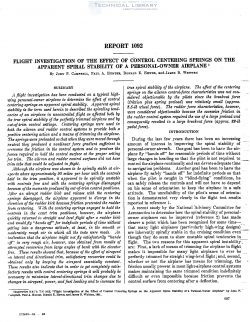naca-report-1092

- Version
- 188 Downloads
- 2.00 MB File Size
- 1 File Count
- September 7, 2016 Create Date
- September 7, 2016 Last Updated
NACA Description Adjustments Flight Investigation of the Effect of Control Centering Springs on the Apparent Spiral Stability of a Personal Owner Airplane

A flight investigation has been conducted on a typical high-
un'ng personal-owner airplane to determine the eject of control
centering springs an apparent spiral stability. Ap parent spiral
stability is the term used herein to described the spiraling tend-
encies of an airplane in uncontrolled flight as afl'ected both by
the true spiral stability of the perfectly trimmed airplane and by
out—of-tri-m control settings. Centering springs were used in
both the aileron and rudder control systems to provide both _a
posit-ire centering action and a means of trimming the airplane.
The springs urere preloaded so that whenthey were mated through
neutral they produced a nonlinear force gradient sujficient to
orercome the friction in the control system and to produce the
forces required to hold the control surface at the proper setting
for trim. The aileron and rudder control surfaces did not hate
trim tabs that could be adjusted in flight.
Although the airplane was shown to be spirally stable at air-
speeds aboce approximately .90 miles per hour with the controls
held in the trim posititm. it appeared to be spirally unstable
with controls free and with the centering springs disengaged
because of the moments produced by out~of-trirn control positions.
.-l_fter an abrupt rudder kick and release with the centering
springs disengaged, the airplane appeared to diverge in the
direction of the-rudder hick because friction prevented the rudder
from centering. With the centering springs engaged to hold the
controls in the exact trim positions, howerer, the airplane
quickly returned to straight and lecel flight after a rudder icicle
and would fl y “hands ofl” for indefinite periods of time without
getting into a dangerous attitude, at least, in the smooth or
moderately rough air in which all the tests were made.
An indication that the airplane might not fly satisfactorily “hands
"If" in very rough air, however, was obtained from results of
attempted recoreries from large angles of bank with the elecator
free. These results showed that, because of the eject of airspeed
on lateral and directional trim. satisfactory recoveries could be
obtained only by keeping the airspeed essentially constant.
| File | Action |
|---|---|
| naca-report-1092 Flight Investigation of the Effect of Control Centering Springs on the Apparent Spiral Stability of a Personal Owner Airplane.pdf | Download |

Comment On This Post